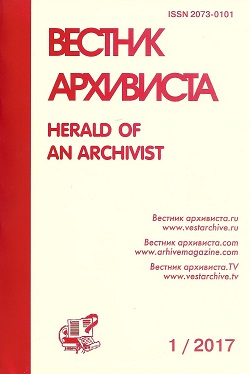Scientific article
УДК 778.5.03.03.с(09)+778.5ср(092)+94(470)
DOI 10.28995/2073-0101-2021-4-1051-1063
Golovnev, Ivan A.
Peter the Great Museum of Anthropology and Ethnography, Russian Academy of Sciences, St. Petersburg, Russian Federation
Images of Soviet Colonization in Archival Cinema: “Jews on the Earth” by Abram Room: The 1920s–30s
Abstract
At the turn of the 1930s, the Soviet film industry actively released documentary films about life of remote regions of the country, giving its audience an opportunity to make virtual trips across the “sixth part of the Earth.” This phenomenon had a political background: unification of leading creative and scientific forces for creation of the screen image of a multi-structured, multinational, and successfully developing socialist country within the frameworks of state project “Cinema Atlas of the USSR.” The article is to introduce into scientific use an archival documentary “Jews on the Earth” (1927) directed by Abram Room, a film telling about the state program for Jewish settlement of the northern Circum-Pontic region. The socio-political, cultural, and ideological context of its creation is analyzed. The study draws on little-known visual and textual archives, as well as on data of the Soviet periodicals and excerpts from the screenwriter V.B. Shklovsky’s theoretical heritage. Due to specifics of silent cinema, the film “Jews on the Earth” is a kind of cinematic text, consisting of approximately equal number of alternating film frames and text credits written by Vladimir Mayakovsky and Lily Brick. The film story is a sequence of episodes describing agrarization of the Jewish population, its “exodus” from the destroyed miasteczkos to the fertile southern lands. In the course of the research, it becomes obvious that this film is an example of the propaganda films describing the success of early Soviet colonization projects. The method used by Abram Room when working on the “Jews on the Earth” was a creative combination of the documentary and feature film techniques, allowing the film not just to convey dry information, but also to highlight socio-cultural context of the events. The film’s significance was in its contribution to the visual chronicle of the Soviet colonization and to the development of the myth of existence of the Jewish community in the USSR. It is concluded that this film, even overcoming the frameworks of purely propagandistic narration and becoming an outstanding phenomenon of cinematographic art, remains a significant example of the visual anthropology of the Soviet period, as well as a multilayered historical source that has not lost its relevance for modern scientific study.
Keywords
Archival cinema, Soviet cinema industry, visual anthropology, Abram Room, Cinema-Atlas of the USSR, Jewish settlement of the northern Circum-Pontic region.
Download the article: golovnev_doi
References
GOLOVNEV, I. A. Kinoatlas SSSR: “Birobidzhan” Mikhaila Slutskogo [The USSR Cinema-Atlas: Mikhail Slutsky’s “Birobidzhan.” In Russ.]. IN: Sibirskie istoricheskie issledovaniya, no. 4, pp. 13–32.
GOLOVNEV, I. A. Etnokul'turnye soobshchestva v arkhivnom kino: “Za Polyarnym krugom” Vladimira Erofeeva [Ethnocultural Communities in Archival Films: Vladimir Erofeev's “Beyond the Arctic Circle.” In Russ.]. IN: Vestnik arhivista / Herald of an archivist, 2020, no. 3, pp. 705–718.
GRASHENKOVA, I. N. Abram Room [Abram Room. In Russ]. Moscow, Iskusstvo publ., 1977, 280 p.
MAZUR, L. N. Konstruirovanie revolyutsionnogo mifa v sovetskom khudozhestvennom kinematografe. 1917-1953 gg. [Designing the Revolutionary Myth: Soviet Feature Films of 1917-1953. In Russ.]. IN: Vestnik arhivista – Herald of an Archivist, 2017, no. 3, pp. 168-182.
SOKOLOV, R. A., SUKHORUKOVA, A. S. Vospominaniya uchastnikov sobytii 1917 g. kak dokumental'naya osnova kinofil'ma S.M. Eizenshteina “Oktyabr'” [Memoirs of the participants in the 1917 events as a documentary basis for S. M. Eisenstein’s film “October.” In Russ.]. IN: Noveishaya istoriya Rossii, 2019, no. 2, pp. 501–514.
SHKLOVSKII, V. B. Room. Zhizn' i rabota [Room: His life and work. In Russ.]. Moscow, Teakinopechat’ publ., 1929, 14 p.
DEKEL-CHEN, J. L. Farming the Red Land: Jewish Agricultural Colonization and Local Soviet Power, 1924–1941. Yale University Press, 2005.
About the authors
Golovnev Ivan Andreevich, PhD in History, Peter the Great Museum of Anthropology and Ethnography, Russian Academy of Sciences, researcher, St. Petersburg, Russia, +7-922-600-46-41, This e-mail address is being protected from spambots. You need JavaScript enabled to view it
Grant information
This research has been supported by the Russian Science Foundation as a part of the project no. 21-18-00518, https://rscf.ru/en/project/21-18-00518/
Submitted 23.04.2021, published (for citation):
GOLOVNEV, I. A. Obrazy sovetskoi kolonizatsii v arkhivnom kino: “Evrei na zemle” Abrama Rooma. 1920–1930-e gg. [Images of Soviet Colonization in Archival Cinema: “Jews on the Earth” by Abram Room: The 1920s–30s. In Russ.]. IN: Vestnik arhivista / Herald of an Archivist, 2021, no. 4, pp. 1051-1063. doi 10.28995/2073-0101-2021-4-1051-1063














